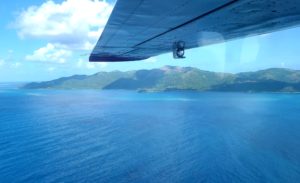 Guanaja – several months ago I had never heard of the place and didn’t know where it was. It’s part of Honduras, off the coast in the Bay Islands. Guanaja sits directly west of Guatemala and about 43 miles due north of Honduras’ mainland in the Caribbean Sea. People are generally more familiar with it’s bigger island-sister Roatan, which is 7.5 miles away or about a 25 minute flight in a Cessna plane.
Guanaja – several months ago I had never heard of the place and didn’t know where it was. It’s part of Honduras, off the coast in the Bay Islands. Guanaja sits directly west of Guatemala and about 43 miles due north of Honduras’ mainland in the Caribbean Sea. People are generally more familiar with it’s bigger island-sister Roatan, which is 7.5 miles away or about a 25 minute flight in a Cessna plane.
Guanaja is made up of lush, green, mountainous terrain that meets the crystal blue ocean’s edge with spans of fine, white, sandy beaches. The island is surrounded by incredible, pristine flats and a coral reef which is part of the Meso-American Barrier Reef – second only to the Great Barrier Reef off the coast of Australia. Along with fishing, it boasts amazing diving opportunities. The island has it’s own fresh, spring water source and 3 waterfalls. With a total population of under 6000, the island is still very undeveloped. Low Cay or Bonacca, a very small cay near the main island of Guanaja, is home to and the center of activity, to about 5000 of the islands’ total population. It’s so densely populated that many of the homes and businesses are built on stilts above the water and has been referred to as the “Venice of Honduras”.
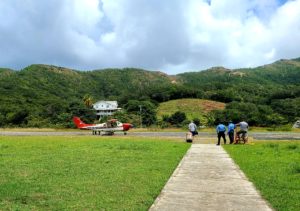 Guanaja has two other main settlements on the island, Savannah Bight and Mangrove Bight plus three much smaller ones. Fly Fish Guanaja is located in Mangrove Bight on the north side of the island in a cozy, picturesque fishing village that quickly feels like home. It’s a quiet place with the exception of the constant chorus of life from birds, roosters, dogs and horses that all seem to be talking to one another. Locals are friendly, welcoming and eager to converse and share their culture with you. Guanaja was previously a British Colony and most inhabitants are descendants of British families that through the years, have mixed with Caribbean/Spanish descents. Sur names are mostly common English names like Roberts, Moore and Jackson and English is their first language with Spanish spoken second. The island has a rich and colorful history, complete with Christopher Columbus landing there in 1502, cacao, buccaneers and pirates.
Guanaja has two other main settlements on the island, Savannah Bight and Mangrove Bight plus three much smaller ones. Fly Fish Guanaja is located in Mangrove Bight on the north side of the island in a cozy, picturesque fishing village that quickly feels like home. It’s a quiet place with the exception of the constant chorus of life from birds, roosters, dogs and horses that all seem to be talking to one another. Locals are friendly, welcoming and eager to converse and share their culture with you. Guanaja was previously a British Colony and most inhabitants are descendants of British families that through the years, have mixed with Caribbean/Spanish descents. Sur names are mostly common English names like Roberts, Moore and Jackson and English is their first language with Spanish spoken second. The island has a rich and colorful history, complete with Christopher Columbus landing there in 1502, cacao, buccaneers and pirates.
 Getting to Guanaja is easy. It’s a direct flight from Houston to Roatan. From there, you have the option of a quick flight or slightly longer boat ride to the island. I chose the flight and landed on the small airstrip 25 minutes later. Kendall Witt, Fly Fish Guanaja lodge manager, who happens to be a Colorado native, now a Guanaja resident and family man, met me and my husband, Erik, at the airport to transfer us to the lodge in a flats boat. It was a pleasant ride and my eyes immediately began scanning the water to look for fish. It’s a habit.
Getting to Guanaja is easy. It’s a direct flight from Houston to Roatan. From there, you have the option of a quick flight or slightly longer boat ride to the island. I chose the flight and landed on the small airstrip 25 minutes later. Kendall Witt, Fly Fish Guanaja lodge manager, who happens to be a Colorado native, now a Guanaja resident and family man, met me and my husband, Erik, at the airport to transfer us to the lodge in a flats boat. It was a pleasant ride and my eyes immediately began scanning the water to look for fish. It’s a habit.
Once arrived, we settled in, unpacked gear and got a tour. Kendall gave us the rundown as we enjoyed appetizers and a cocktail, then introduced us to staff. It was a perfect start to the trip and nice to have a little time to chill and soak it all in. That evening we prepared our gear, indulged in a delicious dinner and fell asleep as soon as our heads hit the pillow. Morning would come early and breakfast would be served at 6:30am.
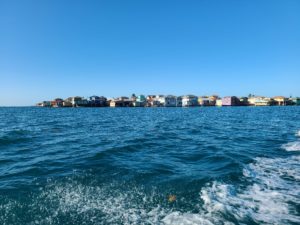 At about 10 miles long and 3 miles wide, the island of Guanaja is small and navigable, but big enough to provide a wide variety of fishing spots with primary targets being bones, triggers, and permit. The flats are packed and easy to walk on with only a few places that would be described as muddy. If we had come during a less windy week, this would have been an absolute killer tenkara trip. Also, there seemed to be less barracudas and sharks than in the Bahamas. These apex predators are ever-present on flats and during our recent fly fishing trip to Andros South Lodge, landing bonefish before they were taken out by these pervasive hunters was a real challenge, and made me think twice about sloshing around in the water. In Guanaja, the occasional shark or barracuda would cruise a shallow flat and make a school of bones nervous, but we didn’t have the multitude of ambush attempts that we did in the Bahamas. So beyond the shear size of the fish we encountered, the island was a great place for fly fishing tenkara style.
At about 10 miles long and 3 miles wide, the island of Guanaja is small and navigable, but big enough to provide a wide variety of fishing spots with primary targets being bones, triggers, and permit. The flats are packed and easy to walk on with only a few places that would be described as muddy. If we had come during a less windy week, this would have been an absolute killer tenkara trip. Also, there seemed to be less barracudas and sharks than in the Bahamas. These apex predators are ever-present on flats and during our recent fly fishing trip to Andros South Lodge, landing bonefish before they were taken out by these pervasive hunters was a real challenge, and made me think twice about sloshing around in the water. In Guanaja, the occasional shark or barracuda would cruise a shallow flat and make a school of bones nervous, but we didn’t have the multitude of ambush attempts that we did in the Bahamas. So beyond the shear size of the fish we encountered, the island was a great place for fly fishing tenkara style.
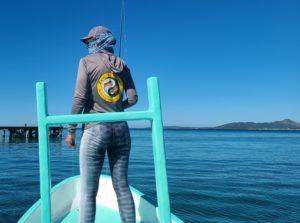 As it turns out, April is one of their windiest months. The locals refer to it as ‘Easter Weather’. That translates to mean mild temperatures but high wind. In the salt, wind seems to always be a factor. Good guides work hard to keep it at your back or find areas that offer protection. It’s just not always possible to do and bottom line, the fish are not always in the protected bays and the shot is where the fish is. Targeting bigger, powerful species on a fixed-line tenkara rod works best when you can move. It’s also a little easier to sneak up on fish wading, verses in a boat. So being on foot in the salt is always preferred when fly fishing tenkara style. On this trip, it just wasn’t going to happen much. That was okay. Versatility and flexibility are the true signs of an excellent angler. Being skilled and proficient in both methods of fly fishing is important to me. This trip would be another opportunity to practice long casts into strong wind, on a dime for accuracy, and in a split second under pressure. And depending on wind and visibility, maybe I’d get a shot or two on tenkara.
As it turns out, April is one of their windiest months. The locals refer to it as ‘Easter Weather’. That translates to mean mild temperatures but high wind. In the salt, wind seems to always be a factor. Good guides work hard to keep it at your back or find areas that offer protection. It’s just not always possible to do and bottom line, the fish are not always in the protected bays and the shot is where the fish is. Targeting bigger, powerful species on a fixed-line tenkara rod works best when you can move. It’s also a little easier to sneak up on fish wading, verses in a boat. So being on foot in the salt is always preferred when fly fishing tenkara style. On this trip, it just wasn’t going to happen much. That was okay. Versatility and flexibility are the true signs of an excellent angler. Being skilled and proficient in both methods of fly fishing is important to me. This trip would be another opportunity to practice long casts into strong wind, on a dime for accuracy, and in a split second under pressure. And depending on wind and visibility, maybe I’d get a shot or two on tenkara.
 We worked the flats according to tides and wind, and stayed on the boat almost exclusively since it provided a better vantage point. Similar to my recent trip to South Andros, Bahamas, I primarily used my Winston 8wt for bonefish and kept my Winston 10wt set up for and dedicated to permit. Even from atop the boat with the sun shining overhead and zero clouds, visibility was low due to 20-27mph winds tearing up the surface of the water. No question, we’d be working hard for every shot we got. Casting in these conditions, however annoying it can be, only makes you better and teaches you a lot – about technique and about yourself. Knocking out a 75ft, 80ft or 90ft cast while practicing at a park is one thing. Reproducing that same cast in the wind, while standing on a bouncing boat, trying to spot your target, and doing it all in just a few seconds well, that’s not easy. Fun but not easy. Even tougher is keeping a calm head when you see your fish and your heart starts pounding and all that adrenaline surges through your body.
We worked the flats according to tides and wind, and stayed on the boat almost exclusively since it provided a better vantage point. Similar to my recent trip to South Andros, Bahamas, I primarily used my Winston 8wt for bonefish and kept my Winston 10wt set up for and dedicated to permit. Even from atop the boat with the sun shining overhead and zero clouds, visibility was low due to 20-27mph winds tearing up the surface of the water. No question, we’d be working hard for every shot we got. Casting in these conditions, however annoying it can be, only makes you better and teaches you a lot – about technique and about yourself. Knocking out a 75ft, 80ft or 90ft cast while practicing at a park is one thing. Reproducing that same cast in the wind, while standing on a bouncing boat, trying to spot your target, and doing it all in just a few seconds well, that’s not easy. Fun but not easy. Even tougher is keeping a calm head when you see your fish and your heart starts pounding and all that adrenaline surges through your body.
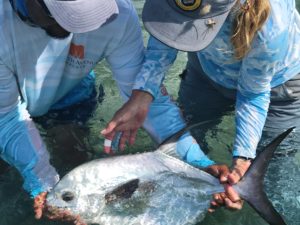
In reality, the primary goal of this trip was permit. Bonefish were the “filler fish”. I took my Zen Kyojin Tenkara rod everyday but didn’t actually use it until the last. On my reel I landed many bonefish as well as two permits plus one that broke off. I had lots of other follows, several that just didn’t take, a few missed hook sets and a couple that snuck in from the back door and by the time we spotted them, were just too close to cast and strip to. I felt pretty satisfied as far as permit fishing and figured I had one last day to try tenkara. As a note, I have landed permit on my tenkara rod – junior permits though. These permit were big – 15lbs up to about 30lbs was typical. These were too big to target on a fixed line. I would have to target bones – which were big too. All the bonefishing we were doing was sight fishing. We weren’t casting to big schools, more often it was a single, double or small groups up to 5. We decided we would head out earlier than usual and hit the flats at rock bottom low tide, before permit started pushing in. Not only would the wading be easier, we were hoping we’d have a little less wind and we’d find some tailing bones.
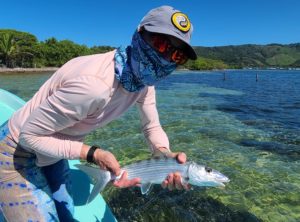
Guides know their water and that’s why they’re worth their weight in gold. We headed to the east side of the island, bouncing through choppy white caps and arrived in a spot that looked promising. I was assessing the area, rocks and wind, while my guide Ranklen, tied on a new leader and fly onto the Kyojin. We were all pretty excited and feeling the pressure of it being the last day. Ranklen, had heard about tenkara but had never seen a rod or watched one in action. He was stocked and enthusiastic. I extended all the sections, rolled my line in my hand and we headed out wading, in search of tails. Along our walk I cast to a few triggers and had one follow over and over, but never take the fly. Then as if on cue, wakes were noticed and tails could be seen in the distance. Slowly we made our way towards them. They seemed calm and were feeding. The stars were aligning for us.

As we got nearer, we could see a small group of big bones that were feeling pretty comfortable in a swallow pool at the edge of the reef. The wind was howling but at our backs. I had a 28ft Fusion Line with a 12ft leader. What I didn’t know was that it was 12lb test, not the usual 15lb or 16lb that I typically use on the rod when targeting these fish. Pound for pound, bonefish are said to be the most powerful fish in the ocean. They are like silver bullets when they rip into motion and this group had some beauties. I would be casting at 5-10lb fish (bigger than the usual 3-6lb bones I usually cast to) and praying that I could get my fly close enough without spooking them. I made several conservative casts wary of the wind. They were short but at least I didn’t spook anyone. Skinny water, turtle grass and some rocks meant I had to keep the fly moving so it wouldn’t snag on the bottom, but needed a pace that would allow a fish to take.
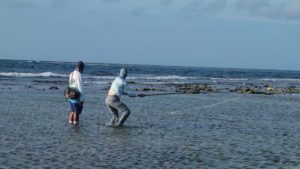
I cast again, nearer this time, and had a few short follows. I snagged some coral and the fish retreated. No spooks so we were still good. The fish began to move more and we started to suspect our time might be running out. Ranklen kept his eyes on them and directed me where to aim. Casting almost directly into the wind I managed to softly place the fly in tight and immediately started to side strip. A fish was following. I continued stripping while taking a few step backward when the bonefish finally hit. This guy was big, a solid 8 pounder that made a wake and was on the move. I worked to stay in the power curve and keep the rod low. Ranklen was worried about the rocks and coral cutting my line. He was yelling at me to lift my tip. As I’m working the fish I’m yelling back at him explaining that the tip could break if I did that and for a few moments there was a lot of hollering back and forth over the wind. Both of us wanted that fish real badly. Neither of us wanted it to lose it.

Everything seemed fine and I was managing the fish, moving him in a circular motion but keeping him tight. This allows for movement but keeps his head turned in one direction or an other. Meanwhile, on the only day during this fishing adventure that I decide to wear long, baggy, quick-dry pants, instead of my usual low friction, low resistance tights, I am struggling to keep up with this pig with rocket packs on its back. And as if in a dream, Ranklen’s voice fades and my attention turns away from my pants and the drag they are causing, towards a sublime awareness that I have, in a single nano-of-an-instant, allowed the rod to slip slightly forward from it’s full power position. In that bit of time, which I have played over and over again in my mind, I instinctively do what I have done so many times before to regain control. I pull back in an attempt to turn the fish around. When I do this and slow my pace to bare down and redirect all that fury of momentum into a turn, my 12lb tippet on this 8lb Flash Gordon fish, snaps. All tension is gone and the line falls limp into the water. The fish is lost, but as we say, not forgotten. Everything stops and silence is broken only by the sound of wind. What an experience. Breathe. Magnificence in action. Breathe. Pure power. Breathe. But gone.

Ranklen is thrilled and almost speechless. Sounds are being made but not of actual words. I am overwhelmed, with joy, with disappointment, with pride. Even though I didn’t land the fish, I got it done and got a bonefish of that magnitude to take my fly on a tenkara rod. I held onto the fish, and the rod, my rod, handled it. An 8lb bonefish on tenkara! I feel certain if I had my usual 15lb test, I would have landed that damn fish.
The tide was moving and permit would begin to push in. It was time to tuck the tenkara rod into my backpack and pull out the 10wt. Ranklen was the tide time keeper. I was sad this was our last day to be in Guanaja. Although I felt extremely satisfied and was quite certain no one had ever done what I had just done, I couldn’t help but think, if I just had one more day… Even the guide was confident that with bigger test, I could get the job done. The loss was not a failure. In fact, this loss was mostly a success. It gave me confidence to do it again. I went to Andros South Lodge last month looking for bigger bones to land on my tenkara rods. The bonefish were huge but conditions made it tough – not impossible but very tough. Here, the bones are huge and the flats are packed and maneuverable. I know I can be successful given a few more opportunities. I’ve already decided to come back. I’ll avoid ‘Easter Weather ‘and put up with more heat in exchange for less wind. Visibility will be better and spotting fish while wet wading, easier. I’ll spend more time off the boat and in the water with tenkara rod in hand. I’ll have plenty of shots at 8lb+ bonefish and know what I need to land them without a reel. I believe I can do this.

With every experience, missed hook set and failed landing, I learn. It makes me better and want it even more. I know that there is a limit to what I can do without a reel and I like hovering just above that spot in the realm of the unknown. It creates a hunger, an unsettled feeling made up of a million ‘what ifs’. It makes me nervous and pace the floor in my mind. Some people are uncomfortable in places like this. But it stirs me. The challenge, the adrenaline, the primal joy and euphoria I feel when it all comes together for a magical moment and works, is addictive. That rush, that high lasts for days and even after years have past, it can be re-lived and felt again with a simply memory, of that day fishing…in Guanaja.
I’d like to thank @flyfishguanaja for a spectacular time and all the hospitality they showed us. Thank you Steve Calaway Brown, Beckie Brown, Kendall Witt, Daisy Jackson, Melinda Jackson, Walter, all the Fly Fish Guanaja staff and of course their incredible guides: Kendell, Edwin and Ranklen who worked so hard to get us into fish and made each day incredibly and fun. Yours is a special place – thank you for sharing it with us. We will be back.
Karin Miller





I love your Kyojin bone story!
Anyone who thinks that’s a failure does not understand!
Thanks Rhad – it was a thrill and if anyone understands, I know it’s you. Keep chasing those big one and having fun. Next time I get a chance at an 8lb bonefish, I’m landing it.
Karin, you do find the best locations to fish. I know thee are not relaxing trips and always wish you well. My back and shoulders will not withstand the effort necessary for casting to and catching these fish. Still, I have good memories and will continue using my Tenkara rods and flies whenever possible. Meanwhile I am watching the snow not melt and am interested in your selection of new floating lines.
Richard Wheeler
Hi Richatd and thanks for reafing the article. I will confess that it takes a lot of “work” to fish 7 or 8 days and saltwater is strenuous…casting in high winds, wading flats and just balancing on the bow of a small flats boat can be very tiring. In regards to our new line series, we are hoping they will be available by early summer. RIO is producing them for us and like most manufacturers, are still playing catch-up from Covid setbacks. We have worked very hard on our new Fusion Lines and are excited to collaborate with a great company like RIO. We’ll definietly be posting about it when they are completed.